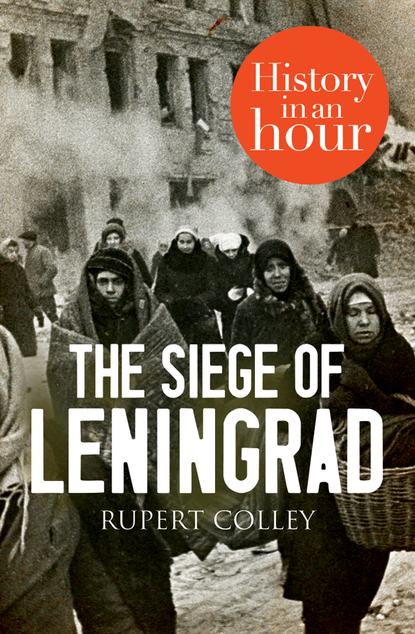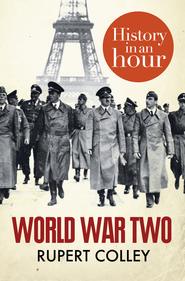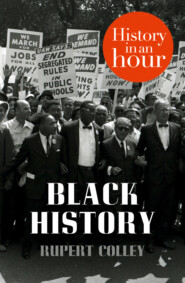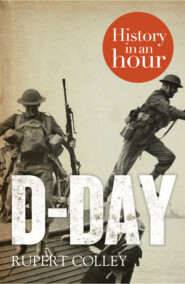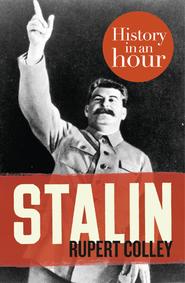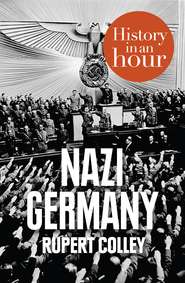По всем вопросам обращайтесь на: info@litportal.ru
(©) 2003-2024.
✖
The Siege of Leningrad: History in an Hour
Настройки чтения
Размер шрифта
Высота строк
Поля
Stalin’s first act was to send Vyacheslav Molotov, his foreign minister, to announce the war to his people. Molotov’s radio broadcast, relayed across cities by loudspeaker eight hours after the initial attack, condemned this ‘act of treachery unprecedented in the history of civilized nations.’
On 3 July, in his first public address since the invasion, Stalin spoke of ‘The Great Patriotic War’. His usual political rhetoric, while still apparent, was played down. Instead, he spoke in patriotic terms, pulling together his people to defeat the beast that was now in their midst: ‘Comrades, citizens, brothers and sisters, men of our Army and Navy! My words are addressed to you, dear friends!’ he began. He continued, ‘The issue is one of life and death for the Soviet State, of life and death for the peoples of the USSR; the issue is whether the peoples of the Soviet Union shall be free or fall into slavery.’
Preparing the City for War (#ulink_057f6272-144a-563c-9836-1a6410dd2d65)
As soon as war was announced, Leningrad was placed under martial law. The writer Lidiya Ginzburg described the immediate change of atmosphere within the city:
Less than half an hour had passed and we were already being borne away inexorably from our pre-war emotional cast of mind. [We had] a feeling . . . that this life was coming to an end.
On 27 June, Andrei Zhdanov, Stalin’s man in Leningrad, issued orders for the mobilization of the city’s population to bolster its defences. Unless sick, pregnant, caring for infants, or otherwise engaged by the city authorities or the military, all men aged between sixteen and fifty, and women between sixteen and forty-five were called up. They were to work for seven days followed by four days’ rest when they would be expected to return to their normal jobs or studies. In August the age range was extended – up to fifty-five for men and fifty for women. Work shifts were increased too – seven days work, then one day of rest.
‘Everyone to the defence of Leningrad’, Kazan Cathedral, October 1941
RIA Novosti archive, image #637354 / Anatoliy Garanin / CC-BY-SA 3.0
But in practice, these guidelines were never adhered to. One woman of fifty-seven years of age, wrote of eighteen-day shifts, twelve hours a day hacking at ground ‘as hard as rock’. Few were accustomed to such strenuous, unrelenting work. Teenage girls with soft hands would turn up wearing summer dresses and sandals and were expected to dig and manoeuvre concrete blocks using just their hands and a crowbar. People always reported for work either out of patriotic duty or because the penalties for failing to do so were too harsh to contemplate. Occasionally the workers were subjected to enemy bombs or strafing (a machine-gun attack fired from low-flying German fighter planes).
Up to half a million civilians turned out to various points on the outskirts of the city to construct three fortified rings – the furthest, 70 miles west of the city, ran along the River Luga. Their efforts produced 650 miles of trenches, 430 miles of anti-tank ditches, over 5,000 concrete gun emplacements (or pillboxes), and 370 miles of barbed-wire entanglements.
It was a valiant effort but many resented the amount of labour, believing that when the Germans came they would simply overrun these defences. Their cynicism was well founded – the advance of the Germans continued unabated. Having stormed through the Baltic States, the German war machine seemed unstoppable. Stalin’s speech on 3 July had extolled ‘all citizens of the Soviet Union [to] defend every inch of Soviet soil, [and] fight to the last drop of blood for our towns and villages.’ Taking his cue, Zhdanov announced the formation of a ‘People’s Volunteers’ Militia’ within Leningrad. Again, either through patriotism or through coercion, thousands answered the call. Age and health was no barrier – one sickly man in his late fifties was told, ‘Your state of health is of no significance, what is important is the very act of volunteering and thereby displaying one’s political attitude.’ Another, hoping to avoid this voluntary conscription was told, ‘You are a Soviet man – you cannot refuse to volunteer. I advise you not to refuse.’ By the end of August 1941, 160,000 Leningraders, 32,000 of them women, had volunteered.
Red Army soldiers go into battle, 1943
RIA Novosti archive, image #93172 / Vsevolod Tarasevich / CC-BY-SA 3.0
The volunteers received precious little training and were, if lucky, equipped only with out-of-date weapons – old rifles, grenades and instructions on how to make petrol bombs, colloquially known as Molotov cocktails. The first division of this amateur army was formed on 10 July and after cursory training, sent to the front to join the regular soldiers of the Red Army on 14 July. Not many survived. Women and children were advised that if the Germans broke into the city, they should pelt them with stones or throw boiling water over them. The instruction caused resentment – if the Red Army was incapable of stopping the Germans, then what chance the civilian?
As soon as war was announced, sandbags started appearing. All the city’s famous monuments were soon covered, as were civic buildings and museums. Then houses and apartment blocks were sandbagged. People put sticky tape in their windows in a criss-cross pattern to prevent the glass from shattering when the bombs started falling. Privately owned radios were confiscated, lest civilians were adversely influenced by enemy propaganda. As owners of radios had had to register their purchase, it was not difficult for the authorities to keep tabs on those who failed to hand in their radios. They were allowed instead to have small loudspeakers within their homes, wired to the city’s public address system, which routinely broadcast patriotic messages and warned against defeatism or cowardice.
Posters, leaflets, noticeboards and newspapers sprung up, all reinforcing the correct message. Rumour-mongers faced harsh penalties for their loose tongues. But rumours of course circulated, especially once the fighting had started. The loud speakers, in Orwellian portent, blared continually of the successes at holding the Fascists at bay but kept hidden the huge loss of life as ill-prepared and ill-equipped troops went into battle.
The propaganda warned constantly of the enemy within and whipped up a frenzy of spy mania. People became convinced that German agents and fifth columnists were within their midst, sabotaging their efforts and relaying vital information back to the Germans. The paranoia was perhaps justified – the Germans had captured a warehouse full of Red Army uniforms. Anyone who looked different, with clothes considered too Western, or with an accent or name that sounded foreign, was eyed with suspicion. Almost 12 per cent of Leningrad’s 1941 population was of German, Finnish or Baltic descent, and many were interned for the duration of the war. Tram conductors were banned from calling out the names of stations so as to confuse any potential spies on their carriages; city maps and guidebooks were withdrawn from bookshops and libraries; church bells and factory whistles were silenced. Someone asking for directions was suddenly viewed as a suspect and anyone acting ‘oddly’ was liable to be reported.
On 18 July, food rationing was introduced. People were given ration cards which expired after one month. Even the issuing of ration cards was designed to keep the population in check and on message. There were four categories, with the highest category allocated the largest ration, so it was in the interest of these people to remain in a position so as not to be relegated to a lower category. Working hard in a manner that was recognized and informing on unreliable elements were two ways of maintaining one’s top category. To begin with, food, if not plentiful, was still available but prices shot up making it unavailable for all unless you were deemed worthy enough of being in the top category. Those working in factories were also allocated an extra ration, which provided a strong incentive for workers to remain at their posts, however weak and malnourished they became.
Half a million great works of art belonging to the Hermitage Museum, including collections of diamonds and precious stones, were too vulnerable to remain in the city. Packed into special protective crates, most were shipped out of the city towards the Urals in an armoured 31-car train, far away from the German bombs. The museum’s chief curator wept as the train departed. Meanwhile, the Hermitage was used as a bomb shelter.
Factory work during the siege
RIA Novosti archive, image #348 / Vsevolod Tarasevich / CC-BY-SA 3.0
Factories were urged to increase output, targeting each individual employee to work harder. Notices were posted by each machine, extolling greater effort, ‘Worker, what have you done for the defence of Leningrad?’ Graphs were displayed each day showing the output of every worker. Those who worked hardest were awarded with a little red flag next to their machine, while those who worked less efficiently were shamed into greater effort and, for the repeat offenders, occasionally subjected to a mock trial. In July 1941, the city began to evacuate its industrial output. Factories were dismantled and re-erected as far to the east as Siberia and along with the machinery, much of the skilled workforce went with it.
Evacuation (#ulink_aee73a71-d668-5577-b0e9-bd7cff65b66e)
Within a week of the invasion, the city authorities decided to evacuate 392,000 children out of the city. The first evacuations took place on 29 June, taking away the first 15,000 children. The process was chaotic, and dogged with bureaucracy resulting in heartbreaking scenes and sometimes tragedy. Mothers not engaged in essential work were allowed to accompany their children. But often families were split up, with the mothers transported while their children were left behind. The first trains packed with children promptly went in the wrong direction, to the west, heading straight towards the Germans. When they returned to the city, their mothers had already left – in the opposite direction.
After the initial evacuations, the authorities then felt that too many women were leaving and that the city still had need of their labour – their children would have to depart alone. Women became desperate with anxiety. Mothers begged to be allowed to join their children or to keep their children with them. But evacuation was declared compulsory for all children under the age of fourteen. Many of the children would arrive at the station or marshalling yard and, due to the disorganization, be made to wait up to four days. Their food, so carefully packed by their anxious mothers, would be consumed within the first few hours. Rumours that German planes were strafing the evacuation trains caused even greater consternation. The authorities tried to dismiss the rumours as ‘hostile and provocative’ but then rumour became known fact.
The greatest tragedy occurred on 18 August, outside the small town of Lychkovo. One mother remembered her daughter saying, ‘Look, Mummy – a plane! It’s dropping something. Maybe it’s toys.’ The mother flung herself over her child. The planes were German. They flew in low and strafed the train with machine-gun fire then circled round to return, dropping bombs. A scene of utter panic ensued. Amidst the smoke and screams, one witness reported seeing dismembered limbs and children dying. As the planes circled for a third attack, the mothers and children tried to flee across a field only to be shot down by more machine-gun fire.
People were caught in a terrible dilemma. Some thought that perhaps it was safer to evacuate but were reluctant to leave behind their homes and possessions which, in Soviet society, could take years to accrue. Some, requesting to be evacuated, were arrested for being ‘defeatist’; whilst others feigned illness in order not to go. Many felt a sense of shame in leaving, as if they were deserting their beloved city, whilst others wanted to stay in order to welcome in the Germans as liberators. Throughout the war, there was an underlying sense that life under the Germans could be no worse than under the current regime. The Germans were, after all, a ‘cultured people’ that would bring order to the chaos of Soviet life. ‘What about Hitler?’ asked one diarist. ‘He can’t be worse than what we have now and at least they will permit us our churches and praying to God.’
German soldiers taking prisoners
Bundesarchiv, Bild 101III-Niquille-085-10 / Niquille / CC-BY-SA
Many blamed Stalin for the country’s current predicament and lack of readiness, and were disappointed that Stalin hadn’t offered to resign. Such opinions were uttered only in private to loved ones, or occasionally committed to a well-hidden diary. Anyone overheard making such remarks could find themselves reported and arrested. The authorities had no hesitation on clamping down on defeatist talk, ‘loose talk is a crime against the Fatherland’, and asked the population to be its eyes and ears: ‘Let us be vigilant and ruthless in dealing with cowards, panic-mongers, and deserters. Let us establish the strictest revolutionary order’. Hence, outwardly at least, the population displayed great patriotism and loyalty to the city and its regime.
By the end of August over 630,000 civilians had been evacuated. But the city population remained constant as increasing number of refugees, fleeing from the German advance to the west, entered the city. More evacuations were planned, up to 30,000 a day, but when, on 30 August, the town of Mga, 30 miles from Leningrad, was taken by the Germans, the encirclement of the city was virtually complete. There would be no more evacuations. Estimates vary, due to the uncertain number of refugees present in the city, but up to three and a half million Leningraders remained trapped inside. Yet there was only enough food for another three weeks.
The German Advance (#ulink_a2f994eb-27e5-5601-9102-5fe09106ae48)
By 12 July 1941, the German advance had reached the River Luga, the furthest line of fortifications hastily thrown together by Leningrad’s army of defence volunteers. The Soviet soldiers guarding the defences ran off. ‘The gates to Leningrad are open!’ crowed the German commander. Within just three weeks, the Germans had covered almost 500 miles and were now within 60 miles of Leningrad. Thousands of captured Soviet soldiers were forced to march hundreds of miles west to German prisoner-of-war camps, from which many were never to return. The option to transport them by train was dismissed, lest the Russians should ‘contaminate and soil the wagons.’
When the Germans captured the town of Mga, Leningrad lost its last railway station and its link to the rest of the country was severed. A week later, on 8 September, the Germans captured Shlisselburg on the westerly point of Lake Ladoga. This vast lake, 20 miles to the east of Leningrad, would play a significant role during the siege. Meanwhile, the Finns had advanced from the north, reaching the northern shore of the lake, regaining much of the territory they had lost to the Soviet Union during the ‘Winter War’ of November 1939 to March 1940. Leningrad was now virtually an island, cut off from the rest of the country; its people sealed within. It only remained for Hitler to give the order and the city was there for the taking. But Hitler changed tack and decided not to attack the city but to bomb it instead and starve its inhabitants to death. In his directive, dated 22 September, he articulated his intention to ‘wipe the city of Petersburg from the face of the earth.’
Stalin and Kliment Voroshilov, 1935
Hitler based his decision on pragmatism – the risk of going in was too great. His forces were overstretched and in the first three months of the war, his three armies had already lost 180,000 men on Soviet soil. He could ill-afford further losses. Hitler knew the Russians would fight street-by-street and house-to-house (as proved later in the city of Stalingrad); and his commanders feared also that the city would be mined and its population contaminated with various epidemics. As one German officer concluded, ‘It is not worth risking the lives of our troops. The Leningraders will die anyway. It is essential not to let a single person through our front line. The more of them that stay, the sooner they will die. Then we will enter the city without trouble, without losing a single German soldier.’
The German soldier was under strict orders – anyone caught trying to escape the city, man, woman, or child, was to be shot. However, the German command, aware that shooting unarmed women and children could be detrimental to the mental health of the German soldier, ordered the use of artillery which could be applied from a safer distance.
Thus, on 8 September, the German advance halted just seven miles from the city gates, its troops dug in, and prepared to subject Leningrad to the most devastating siege in modern history. It was to last almost 900 days. To the east of the city a small corridor of land, a tiny chink, remained in Soviet hands between the Finns on one side and the Germans on the other; a corridor that was to prove a lifeline for the besieged Leningraders.
The Men in Charge (#ulink_6d5b1156-8af3-5d53-a5e6-a016a5cc7e99)
The men in charge of the defence of Leningrad were Andrei Zhdanov and sixty-year-old Kliment Voroshilov, one of Stalin’s old favourites. Voroshilov had been criticized for his incompetent leadership during the Winter War against Finland and had been dismissed only to be reinstated to save Leningrad. Stalin, aware of Voroshilov’s failings, realized that under such pressure Leningraders would question the regime and his leadership in particular. He needed a man of utter political reliability to instil in Leningrad the right political thinking. And Voroshilov was that man.
Вы ознакомились с фрагментом книги.
Приобретайте полный текст книги у нашего партнера:
Приобретайте полный текст книги у нашего партнера:





